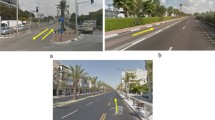Abstract
Although curbside bus stops facilitate the boarding and alighting of buses, they create temporary bottlenecks by reducing vehicular speed and roadway capacity. Further, they cause substantial delays to other vehicles and force them to change lanes. This problem is more severe in developing countries like India, where bus drivers often face difficulties in stopping buses closer to their designated bus stops. In this study, the reasons for the improper stopping of buses and their implications are elaborately discussed by analysing traffic data at two urban arterial sections in New Delhi, India. Both the sections have bus stopping areas marked and no on-street parking is allowed in the curb lane. The reasons for improper stopping include passengers waiting for the bus on the roadway instead of using the bus stop platform, insufficient bus handling capacity of bus stops, standing vehicles in the curb lane (especially auto-rickshaws), etc. Due to the improper stopping of buses, forced lane changes increased and traffic stream speed decreased. Moreover, improper stopping resulted in vehicles queuing behind stopped buses and overtaking buses through the gap between the bus stop and the stopped bus. Such vehicles pose serious safety concerns to the boarding and alighting passengers. This aspect has also been discussed. The current study will be helpful to policy makers, particularly in developing countries in making suitable changes in the regulatory system and bus stop design to reduce the events of improper bus stopping.





Similar content being viewed by others
References
Fitzpatrick K, Nowlin R (1997) Effects of bus stop design on suburban Arterial Operations. Transp Res Rec J Transp Res Board 1571:31–41. doi:10.3141/1571-05
Koshy RZ, Arasan VT (2005) Influence of bus stops on flow characteristics of mixed traffic. J Transp Eng 131:640–643. doi:10.1061/(ASCE)0733-947X(2005)131:8(640)
Yang X, Si B, Huan M (2012) Mixed traffic flow modeling near Chinese bus stops and its applications. J Cent South Univ 19:2697–2704. doi:10.1007/s11771-012-1329-2
Reddy R, Rao S, Rao CR (2008) Modelling and evaluation patterns on the impact of on-street parking in reference to traffic mobility. J Indian Roads Congr 69:101–109
Dhamaniya A, Chand S, Chandra S (2017) Lane change as a measure of capacity reduction near curbside bus stops under mixed traffic conditions. Compendium of Papers, Transportation Research Board 96th Annual Meeting, Washington DC, USA
Lee J-T, Kweon Y-J, Dittberner R, Horodyskyj IM (2014) Drivers’ lane-changing behavior at bus stops on three-lane roadways, Compendium of Papers, Transportation Research Board 93rd Annual Meeting, Washington DC, USA
Tang T-Q, Li Y, Huang H-J (2009) The effects of bus stop on traffic flow. Int J Mod Phys C 20:941–952. doi:10.1142/S0129183109014096
Zhao X-M, Jia B, Gao Z-Y, Jiang R (2009) traffic interactions between motorized vehicles and nonmotorized vehicles near a bus stop. J Transp Eng 135:894–906. doi:10.1061/(ASCE)TE.1943-5436.0000056
Yang X, Gao Z, Zhao X, Si B (2009) Road capacity at bus stops with mixed traffic flow in China. Transp Res Rec J Transp Res Board 2111:18–23. doi:10.3141/2111-03
Ponnaluri RV (2012) Road traffic crashes and risk groups in India: analysis, interpretations, and prevention strategies. IATSS Res 35:104–110. doi:10.1016/j.iatssr.2011.09.002
Toledo T, Koutsopoulos H, Ben-Akiva M (2003) Modeling integrated lane-changing behavior. Transp Res Rec 1857:30–38. doi:10.3141/1857-04
Selten R, Schreckenberg M, Chmura T et al (2004) Experimental investigation of day-to-day route-choice behaviour and network simulations of autobahn traffic in North Rhine-Westphalia. In: Schreckenberg M, Selten R (eds) Human behaviour and traffic networks. Springer, Berlin, pp 1–21
Tirachini A, Hensher DA, Rose JM (2013) Crowding in public transport systems: effects on users, operation and implications for the estimation of demand. Transp Res Part Policy Pract 53:36–52. doi:10.1016/j.tra.2013.06.005
Katz D, Rahman M (2010) Levels of overcrowding in bus system of Dhaka, Bangladesh. Transp Res Rec J Transp Res Board 2143:85–91. doi:10.3141/2143-11
Duduta N, Subedi A (2015) Understanding platform overcrowding at bus rapid transit stations. Transportation Research Board 94th Annual Meeting, Washington DC, USA, 11–15 Jan, 2015.
Currie G, Tivendale K, Scott R (2011) Safety at kerbside tram stops: accident analysis and mitigation. Transportation Research Board 90th Annual Meeting, Washington DC, USA, 23–27 Jan, 2011.
Kim D, Lee YI (2013) Characteristics of driving behavior according to accumulative task loading time of intra-city bus driver. Proc. East. Asia Soc. Transp. Stud 9:2013
Kompier MAJ, Di Martino V (1995) Review of bus drivers’ occupational stress and stress prevention. Stress Med 11:253–262. doi:10.1002/smi.2460110141
Author information
Authors and Affiliations
Corresponding author
Rights and permissions
About this article
Cite this article
Chand, S., Chandra, S. Improper Stopping of Buses at Curbside Bus Stops: Reasons and Implications. Transp. in Dev. Econ. 3, 5 (2017). https://doi.org/10.1007/s40890-017-0033-1
Received:
Accepted:
Published:
DOI: https://doi.org/10.1007/s40890-017-0033-1




